Seagrass
| Seagrasses | |
|---|---|
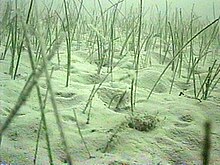
| |
| Cymodocea nodosa | |

| |
| Zostera marina | |
| Scientific classification | |
| Kingdom: | Plantae |
| Clade: | Tracheophytes |
| Clade: | Angiosperms |
| Clade: | Monocots |
| Order: | Alismatales R.Br. ex Bercht. & J.Presl |
| Families | |
|
See Taxonomy | |

Seagrasses are the only flowering plants which grow in marine environments. There are about 60 species of fully marine seagrasses which belong to four families (Posidoniaceae, Zosteraceae, Hydrocharitaceae and Cymodoceaceae), all in the order Alismatales (in the class of monocotyledons).[1] Seagrasses evolved from terrestrial plants which recolonised the ocean 70 to 100 million years ago.
The name seagrass stems from the many species with long and narrow leaves, which grow by rhizome extension and often spread across large "meadows" resembling grassland; many species superficially resemble terrestrial grasses of the family Poaceae.
Like all autotrophic plants, seagrasses photosynthesize, in the submerged photic zone, and most occur in shallow and sheltered coastal waters anchored in sand or mud bottoms. Most species undergo submarine pollination and complete their life cycle underwater.
Seagrasses form dense underwater seagrass meadows which are among the most productive ecosystems in the world. They function as important carbon sinks and provide habitats and food for a diversity of marine life comparable to that of coral reefs.
Overview[]
Seagrasses are a paraphyletic group of marine angiosperms which evolved three to four times from land plants back to the sea. The following characteristics can be used to define a seagrass species. It lives in an estuarine or in the marine environment, and nowhere else. The pollination takes place underwater with specialized pollen. The seeds which are dispersed by both biotic and abiotic agents are produced underwater.[2] The seagrass species have specialized leaves with a reduced cuticle, an epidermis which lacks stomata and is the main photosynthetic tissue. The rhizome or underground stem is important in anchoring. The roots can live in an anoxic environment and depend on oxygen transport from the leaves and rhizomes but are also important in the nutrient transfer processes.[3][2]
Seagrasses profoundly influence the physical, chemical, and biological environments of coastal waters.[2] Though seagrasses provide invaluable ecosystem services by acting as breeding and nursery ground for a variety of organisms and promote commercial fisheries, many aspects of their physiology are not well investigated. Several studies have indicated that seagrass habitat is declining worldwide.[4][5] Ten seagrass species are at elevated risk of extinction (14% of all seagrass species) with three species qualifying as endangered. Seagrass loss and degradation of seagrass biodiversity will have serious repercussions for marine biodiversity and the human population that depends upon the resources and ecosystem services that seagrasses provide.[6][2]
Evolution[]

Terrestrial plants evolved perhaps as early as 450 million years ago from a group of green algae.[7] Seagrasses then evolved from terrestrial plants which migrated back into the ocean.[8][9] Between about 70 million and 100 million years ago, the three independent seagrass lineages (Hydrocharitaceae, Cymodoceaceae complex, and Zosteraceae) evolved from a single lineage of monocotyledonous flowering plants.[10]
Other plants that colonised the sea, such as salt marsh plants, mangroves, and marine algae, have more diverse evolutionary lineages. In spite of their low species diversity, seagrasses have succeeded in colonising the continental shelves of all continents except Antarctica.[11]
Around 140 million years ago, seagrasses evolved from early monocotyledonous land plants, which succeeded in conquering the marine environment. Today, they are a polyphyletic group of marine angiosperms with around 60 species in five families (Zosteraceae, Hydrocharitaceae, Posidoniaceae, Cymodoceaceae, and Ruppiaceae), which belong to the order Alismatales according to the Angiosperm Phylogeny Group IV System.[12] The genus Ruppia, which occurs in brackish water, is not regarded as a "real" seagrass by all authors and has been shifted to the Cymodoceaceae by some authors.[13] The APG IV system and The Plant List Webpage[14] do not share this family assignment.[15]
Seagrasses form important coastal ecosystems.[16] The worldwide endangering of these sea meadows, which provide food and habitat for many marine species, prompts the need for protection and understanding of these valuable resources. Recent sequencing of the genomes of Zostera marina and Zostera muelleri has given better understanding angiosperm adaption to the sea.[17][18] During the evolutionary step back to the ocean, different genes have been lost (e.g., stomatal genes) or have been reduced (e.g., genes involved in the synthesis of terpenoids) and others have been regained, such as in genes involved in sulfation.[18][15]
Genome information has shown further that adaption to the marine habitat was accomplished by radical changes in cell wall composition.[17][18] However the cell walls of seagrasses are not well understood. In addition to the ancestral traits of land plants one would expect habitat-driven adaption process to the new environment characterized by multiple abiotic (high amounts of salt) and biotic (different seagrass grazers and bacterial colonization) stressors.[15] The cell walls of seagrasses seem intricate combinations of features known from both angiosperm land plants and marine macroalgae with new structural elements.[15]
Taxonomy[]
| Family | Image | Genera | Description |
|---|---|---|---|
| Zosteraceae | The family Zosteraceae, also known as the seagrass family, includes two genera containing 14 marine species. It is found in temperate and subtropical coastal waters, with the highest diversity located around Korea and Japan. Species subtotal:
| ||
 |
Phyllospadix | 6 species
| |
 |
Zostera | 16 species
| |
| Hydrocharitaceae | The family Hydrocharitaceae, also known as tape-grasses, include Canadian waterweed and frogbit. The family includes both fresh and marine aquatics, although of the sixteen genera currently recognised, only three are marine.[19] They are found throughout the world in a wide variety of habitats, but are primarily tropical. Species subtotal:
| ||
 |
Enhalus | 1 species
| |
 |
Halophila | 19 species
| |
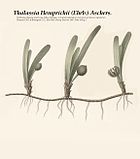 |
Thalassia | 2 species
| |
| Posidoniaceae | The family Posidoniaceae contains a single genus with two to nine marine species found in the seas of the Mediterranean and around the south coast of Australia. Species subtotal: 2 to 9
| ||
 |
Posidonia | 2 to 9 species
| |
| Cymodoceaceae | The family Cymodoceaceae, also known as manatee-grass, includes only marine species.[20] Some taxonomists do not recognize this family. Species subtotal:
| ||
 |
Amphibolis | 2 species
| |
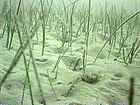 |
Cymodocea | 4 species
| |
 |
Halodule | 6 species
| |
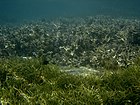 |
Syringodium | 2 species
| |
 |
Thalassodendron | 3 species
| |
| Total species: | |||
Sexual recruitment[]
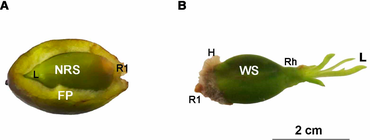
inside a fruit seeds
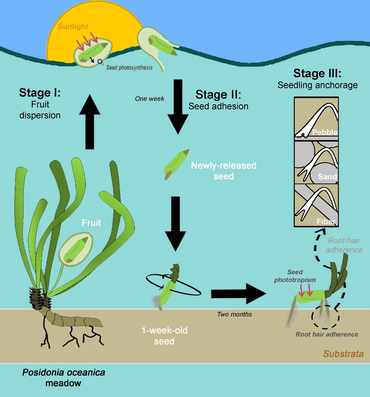
Seagrass populations are currently threatened by a variety of anthropogenic stressors.[22][5] The ability of seagrasses to cope with environmental perturbations depends, to some extent, on genetic variability, which is obtained through sexual recruitment.[23][24][25] By forming new individuals, seagrasses increase their genetic diversity and thus their ability to colonise new areas and to adapt to environmental changes.[26][27][28][29][30][21][excessive citations]
Seagrasses have contrasting colonisation strategies.[31] Some seagrasses form seed banks of small seeds with hard pericarps that can remain in the dormancy stage for several months. These seagrasses are generally short-lived and can recover quickly from disturbances by not germinating far away from parent meadows (e.g., Halophila sp., Halodule sp., Cymodocea sp., Zostera sp. and Heterozostera sp.[31][32] In contrast, other seagrasses form dispersal propagules. This strategy is typical of long-lived seagrasses that can form buoyant fruits with inner large non-dormant seeds, such as the genera Posidonia sp., Enhalus sp. and Thalassia sp.[31][33] Accordingly, the seeds of long-lived seagrasses have a large dispersal capacity compared to the seeds of the short-lived type,[34] which permits the evolution of species beyond unfavourable light conditions by the seedling development of parent meadows.[21]
The seagrass Posidonia oceanica (L.) Delile is one of the oldest and largest species on Earth. An individual can form meadows measuring nearly 15 km wide and can be as much as 100,000 years old.[35] P. oceanica meadows play important roles in the maintenance of the geomorphology of Mediterranean coasts, which, among others, makes this seagrass a priority habitat of conservation.[36] Currently, the flowering and recruitment of P. oceanica seems to be more frequent than that expected in the past.[37][38][39][40][41] Further, this seagrass has singular adaptations to increase its survival during recruitment. The large amounts of nutrient reserves contained in the seeds of this seagrass support shoot and root growth, even up to the first year of seedling development.[35] In the first months of germination, when leaf development is scarce, P. oceanica seeds perform photosynthetic activity, which increases their photosynthetic rates and thus maximises seedling establishment success.[42][43] Seedlings also show high morphology plasticity during their root system development [44][45] by forming adhesive root hairs to help anchor themselves to rocky sediments.[37][46][47] However, many factors about P. oceanica sexual recruitment remain unknown, such as when photosynthesis in seeds is active or how seeds can remain anchored to and persist on substrate until their root systems have completely developed.[21]
Intertidal and subtidal seagrasses[]
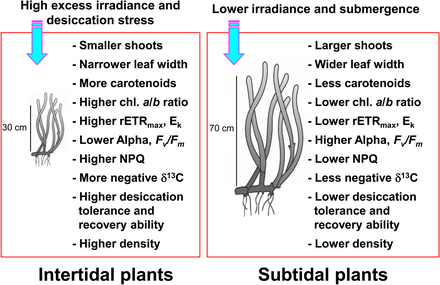
Seagrasses occurring in the intertidal and subtidal zones are exposed to highly variable environmental conditions due to tidal changes.[49][50] Subtidal seagrasses are more frequently exposed to lower light conditions, driven by plethora of natural and human-caused influences that reduce light penetration by increasing the density of suspended opaque materials. Subtidal light conditions can be estimated, with high accuracy, using artificial intelligence, enabling more rapid mitigation than was available using in situ techniques.[51] Seagrasses in the intertidal zone are regularly exposed to air and consequently experience extreme high and low temperatures, high photoinhibitory irradiance, and desiccation stress relative to subtidal seagrass.[50][52][53] Such extreme temperatures can lead to significant seagrass dieback when seagrasses are exposed to air during low tide.[54][55][56] Desiccation stress during low tide has been considered the primary factor limiting seagrass distribution at the upper intertidal zone.[57] Seagrasses residing the intertidal zone are usually smaller than those in the subtidal zone to minimize the effects of emergence stress.[58][55] Intertidal seagrasses also show light-dependent responses, such as decreased photosynthetic efficiency and increased photoprotection during periods of high irradiance and air exposure.[59][60]
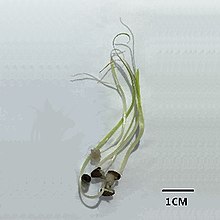
In contrast, seagrasses in the subtidal zone adapt to reduced light conditions caused by light attenuation and scattering due to the overlaying water column and suspended particles.[62][63] Seagrasses in the deep subtidal zone generally have longer leaves and wider leaf blades than those in the shallow subtidal or intertidal zone, which allows more photosynthesis, in turn resulting in greater growth.[53] Seagrasses also respond to reduced light conditions by increasing chlorophyll content and decreasing the chlorophyll a/b ratio to enhance light absorption efficiency by using the abundant wavelengths efficiently.[64][65][66] As seagrasses in the intertidal and subtidal zones are under highly different light conditions, they exhibit distinctly different photoacclimatory responses to maximize photosynthetic activity and photoprotection from excess irradiance.
Seagrasses assimilate large amounts of inorganic carbon to achieve high level production.[67][68] , including seagrass, use both CO2 and HCO−
3 (bicarbonate) for photosynthetic carbon reduction.[69][70][71] Despite air exposure during low tide, seagrasses in the intertidal zone can continue to photosynthesize utilizing CO2 in the air.[72] Thus, the composition of inorganic carbon sources for seagrass photosynthesis probably varies between intertidal and subtidal plants. Because stable carbon isotope ratios of plant tissues change based on the inorganic carbon sources for photosynthesis,[73][74] seagrasses in the intertidal and subtidal zones may have different stable carbon isotope ratio ranges.
Seagrass microbiome[]
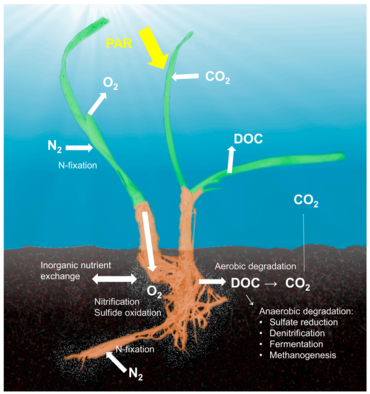
Seagrass holobiont[]
The concept of the holobiont, which emphasizes the importance and interactions of a microbial host with associated microorganisms and viruses and describes their functioning as a single biological unit,[77] has been investigated and discussed for many model systems, although there is substantial criticism of a concept that defines diverse host-microbe symbioses as a single biological unit.[78] The holobiont and hologenome concepts have evolved since the original definition,[79] and there is no doubt that symbiotic microorganisms are pivotal for the biology and ecology of the host by providing vitamins, energy and inorganic or organic nutrients, participating in defense mechanisms, or by driving the evolution of the host.[80] Although most work on host-microbe interactions has been focused on animal systems such as corals, sponges, or humans, there is a substantial body of literature on plant holobionts.[81] Plant-associated microbial communities impact both key components of the fitness of plants, growth and survival,[82] and are shaped by nutrient availability and plant defense mechanisms.[83] Several habitats have been described to harbor plant-associated microbes, including the rhizoplane (surface of root tissue), the rhizosphere (periphery of the roots), the endosphere (inside plant tissue), and the phyllosphere (total above-ground surface area).[75]
Seagrass meadows[]
Seagrass beds/meadows can be either monospecific (made up of a single species) or in mixed beds. In temperate areas, usually one or a few species dominate (like the eelgrass Zostera marina in the North Atlantic), whereas tropical beds usually are more diverse, with up to thirteen species recorded in the Philippines.
Seagrass beds are diverse and productive ecosystems, and can harbor hundreds of associated species from all phyla, for example juvenile and adult fish, epiphytic and free-living macroalgae and microalgae, mollusks, bristle worms, and nematodes. Few species were originally considered to feed directly on seagrass leaves (partly because of their low nutritional content), but scientific reviews and improved working methods have shown that seagrass herbivory is an important link in the food chain, feeding hundreds of species, including green turtles, dugongs, manatees, fish, geese, swans, sea urchins and crabs. Some fish species that visit/feed on seagrasses raise their young in adjacent mangroves or coral reefs.
Seagrasses trap sediment and slow down water movement, causing suspended sediment to settle out. Trapping sediment benefits coral by reducing sediment loads, improving photosynthesis for both coral and seagrass.[84]
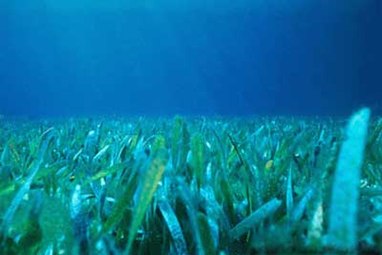
Thalassia testudinum seagrass bed

White-spotted puffers, often found in seagrass areas
Underwater footage of seagrass meadow, bull huss and conger eel
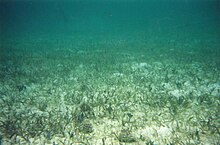
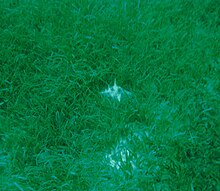
Although often overlooked, seagrasses provide a number of ecosystem services.[85][86] Seagrasses are considered ecosystem engineers.[87][9][8] This means that the plants alter the ecosystem around them. This adjusting occurs in both physical and chemical forms. Many seagrass species produce an extensive underground network of roots and rhizome which stabilizes sediment and reduces coastal erosion.[88] This system also assists in oxygenating the sediment, providing a hospitable environment for sediment-dwelling organisms.[87] Seagrasses also enhance water quality by stabilizing heavy metals, pollutants, and excess nutrients.[89][9][8] The long blades of seagrasses slow the movement of water which reduces wave energy and offers further protection against coastal erosion and storm surge. Furthermore, because seagrasses are underwater plants, they produce significant amounts of oxygen which oxygenate the water column. These meadows account for more than 10% of the ocean's total carbon storage. Per hectare, it holds twice as much carbon dioxide as rain forests and can sequester about 27.4 million tons of CO2 annually.[90]
Seagrass meadows provide food for many marine herbivores. Sea turtles, manatees, parrotfish, surgeonfish, sea urchins and pinfish feed on seagrasses. Many other smaller animals feed on the epiphytes and invertebrates that live on and among seagrass blades.[91] Seagrass meadows also provide physical habitat in areas that would otherwise be bare of any vegetation. Due to this three dimensional structure in the water column, many species occupy seagrass habitats for shelter and foraging. It is estimated that 17 species of coral reef fish spend their entire juvenile life stage solely on seagrass flats.[92] These habitats also act as a nursery grounds for commercially and recreationally valued fishery species, including the gag grouper (Mycteroperca microlepis), red drum, common snook, and many others.[93][94] Some fish species utilize seagrass meadows and various stages of the life cycle. In a recent publication, Dr. Ross Boucek and colleagues discovered that two highly sought after flats fish, the common snook and spotted sea trout provide essential foraging habitat during reproduction.[95] Sexual reproduction is extremely energetically expensive to be completed with stored energy; therefore, they require seagrass meadows in close proximity to complete reproduction.[95] Furthermore, many commercially important invertebrates also reside in seagrass habitats including bay scallops (Argopecten irradians), horseshoe crabs, and shrimp. Charismatic fauna can also be seen visiting the seagrass habitats. These species include West Indian manatee, green sea turtles, and various species of sharks. The high diversity of marine organisms that can be found on seagrass habitats promotes them as a tourist attraction and a significant source of income for many coastal economies along the Gulf of Mexico and in the Caribbean.
See also[]
- Alismatales
- Blue carbon
- Salt marsh
- Mangrove
- Ocean Data Viewer: contains the global distribution of seagrasses dataset
References[]
- ^ Tomlinson and Vargo (1966). "On the morphology and anatomy of turtle grass, Thalassia testudinum (Hydrocharitaceae). I. Vegetative Morphology". Bulletin of Marine Science. 16: 748–761.
- ^ Jump up to: a b c d Papenbrock, Jutta (2012). "Highlights in Seagrasses' Phylogeny, Physiology, and Metabolism: What Makes Them Special?". ISRN Botany. 2012: 1–15. doi:10.5402/2012/103892.
 Material was copied from this source, which is available under a Creative Commons Attribution 3.0 International License.
Material was copied from this source, which is available under a Creative Commons Attribution 3.0 International License.
- ^ Larkum A. W. D., R. J. Orth, and C. M. Duarte (2006) Seagrass: Biology, Ecology and Conservation, Springer, The Netherlands.
- ^ Orth, Robert J.; Carruthers, TIM J. B.; Dennison, William C.; Duarte, Carlos M.; Fourqurean, James W.; Heck, Kenneth L.; Hughes, A. Randall; Kendrick, Gary A.; Kenworthy, W. Judson; Olyarnik, Suzanne; Short, Frederick T.; Waycott, Michelle; Williams, Susan L. (2006). "A Global Crisis for Seagrass Ecosystems". BioScience. 56 (12): 987. doi:10.1641/0006-3568(2006)56[987:AGCFSE]2.0.CO;2. ISSN 0006-3568.
- ^ Jump up to: a b Waycott, M.; Duarte, C. M.; Carruthers, T. J. B.; Orth, R. J.; Dennison, W. C.; Olyarnik, S.; Calladine, A.; Fourqurean, J. W.; Heck, K. L.; Hughes, A. R.; Kendrick, G. A.; Kenworthy, W. J.; Short, F. T.; Williams, S. L. (2009). "Accelerating loss of seagrasses across the globe threatens coastal ecosystems". Proceedings of the National Academy of Sciences. 106 (30): 12377–12381. Bibcode:2009PNAS..10612377W. doi:10.1073/pnas.0905620106. PMC 2707273. PMID 19587236.
- ^ Short, Frederick T.; Polidoro, Beth; Livingstone, Suzanne R.; Carpenter, Kent E.; Bandeira, Salomão; Bujang, Japar Sidik; Calumpong, Hilconida P.; Carruthers, Tim J.B.; Coles, Robert G.; Dennison, William C.; Erftemeijer, Paul L.A.; Fortes, Miguel D.; Freeman, Aaren S.; Jagtap, T.G.; Kamal, Abu Hena M.; Kendrick, Gary A.; Judson Kenworthy, W.; La Nafie, Yayu A.; Nasution, Ichwan M.; Orth, Robert J.; Prathep, Anchana; Sanciangco, Jonnell C.; Tussenbroek, Brigitta van; Vergara, Sheila G.; Waycott, Michelle; Zieman, Joseph C. (2011). "Extinction risk assessment of the world's seagrass species" (PDF). Biological Conservation. 144 (7): 1961–1971. doi:10.1016/j.biocon.2011.04.010.
- ^ Knauth, L. Paul; Kennedy, Martin J. (2009). "The late Precambrian greening of the Earth". Nature. 460 (7256): 728–732. Bibcode:2009Natur.460..728K. doi:10.1038/nature08213. PMID 19587681. S2CID 4398942.
- ^ Jump up to: a b c Orth; et al. (2006). "A global crisis for seagrass ecosystems". BioScience. 56 (12): 987–996. doi:10.1641/0006-3568(2006)56[987:AGCFSE]2.0.CO;2. hdl:10261/88476.
- ^ Jump up to: a b c Papenbrock, J (2012). "Highlights in seagrass' phylogeny, physiology, and metabolism: what makes them so species?". International Scholarly Research Network: 1–15.
- ^ Les, D.H., Cleland, M.A. and Waycott, M. (1997) "Phylogenetic studies in Alismatidae, II: evolution of marine angiosperms (seagrasses) and hydrophily". Systematic Botany 22(3): 443–463.
- ^ Orth, Robert J.; Carruthers, TIM J. B.; Dennison, William C.; Duarte, Carlos M.; Fourqurean, James W.; Heck, Kenneth L.; Hughes, A. Randall; Kendrick, Gary A.; Kenworthy, W. Judson; Olyarnik, Suzanne; Short, Frederick T.; Waycott, Michelle; Williams, Susan L. (2006). "A Global Crisis for Seagrass Ecosystems". BioScience. 56 (12): 987. doi:10.1641/0006-3568(2006)56[987:AGCFSE]2.0.CO;2. ISSN 0006-3568.
- ^ "An update of the Angiosperm Phylogeny Group classification for the orders and families of flowering plants: APG IV". Botanical Journal of the Linnean Society. 181: 1–20. 2016. doi:10.1111/boj.12385.
- ^ Wilkin, Paul; Mayo, Simon J. (30 May 2013). Early Events in Monocot Evolution. ISBN 9781107244603.
- ^ The Plant List (2020). Ruppia. Available online at: http://www.theplantlist.org/1.1/browse/A/Ruppiaceae/Ruppia/ (accessed September 22, 2020).
- ^ Jump up to: a b c d Pfeifer, Lukas; Classen, Birgit (2020). "The Cell Wall of Seagrasses: Fascinating, Peculiar and a Blank Canvas for Future Research". Frontiers in Plant Science. 11: 588754. doi:10.3389/fpls.2020.588754. PMC 7644952. PMID 33193541.
 Material was copied from this source, which is available under a Creative Commons Attribution 4.0 International License.
Material was copied from this source, which is available under a Creative Commons Attribution 4.0 International License.
- ^ Hemminga, M. A., and Duarte, C. M. eds (2000). “Seagrasses in the human environment,” in Seagrass Ecology (Cambridge: Cambridge University Press), 248–291.
- ^ Jump up to: a b Lee, Hueytyng; Golicz, Agnieszka A.; Bayer, Philipp E.; Jiao, Yuannian; Tang, Haibao; Paterson, Andrew H.; Sablok, Gaurav; Krishnaraj, Rahul R.; Chan, Chon-Kit Kenneth; Batley, Jacqueline; Kendrick, Gary A.; Larkum, Anthony W.D.; Ralph, Peter J.; Edwards, David (2016). "The Genome of a Southern Hemisphere Seagrass Species (Zostera muelleri)". Plant Physiology. 172 (1): 272–283. doi:10.1104/pp.16.00868. PMC 5074622. PMID 27373688.
- ^ Jump up to: a b c Olsen, Jeanine L.; et al. (2016). "The genome of the seagrass Zostera marina reveals angiosperm adaptation to the sea". Nature. 530 (7590): 331–335. Bibcode:2016Natur.530..331O. doi:10.1038/nature16548. PMID 26814964. S2CID 3713147.
- ^ Christenhusz, Maarten J.M.; Byng, James W. (20 May 2016). "The number of known plants species in the world and its annual increase". Phytotaxa. 261 (3): 201. doi:10.11646/phytotaxa.261.3.1. ISSN 1179-3163.
- ^ Waycott, Michelle; McMahon, Kathryn; Lavery, Paul (2014). A Guide to Southern Temperate Seagrasses. CSIRO Publishing. ISBN 9781486300150.
- ^ Jump up to: a b c d e Guerrero-Meseguer, Laura; Sanz-Lázaro, Carlos; Marín, Arnaldo (2018). "Understanding the sexual recruitment of one of the oldest and largest organisms on Earth, the seagrass Posidonia oceanica". PLOS ONE. 13 (11): e0207345. Bibcode:2018PLoSO..1307345G. doi:10.1371/journal.pone.0207345. PMC 6239318. PMID 30444902.
 Material was copied from this source, which is available under a Creative Commons Attribution 4.0 International License.
Material was copied from this source, which is available under a Creative Commons Attribution 4.0 International License.
- ^ Collier, C.J.; Waycott, M. (2014). "Temperature extremes reduce seagrass growth and induce mortality". Marine Pollution Bulletin. 83 (2): 483–490. doi:10.1016/j.marpolbul.2014.03.050. PMID 24793782.
- ^ Reusch, T. B. H.; Ehlers, A.; Hammerli, A.; Worm, B. (2005). "Ecosystem recovery after climatic extremes enhanced by genotypic diversity". Proceedings of the National Academy of Sciences. 102 (8): 2826–2831. Bibcode:2005PNAS..102.2826R. doi:10.1073/pnas.0500008102. PMC 549506. PMID 15710890.
- ^ Guerrero-Meseguer, Laura; Sanz-Lázaro, Carlos; Marín, Arnaldo (2018). "Understanding the sexual recruitment of one of the oldest and largest organisms on Earth, the seagrass Posidonia oceanica". PLOS ONE. 13 (11): e0207345. Bibcode:2018PLoSO..1307345G. doi:10.1371/journal.pone.0207345. PMC 6239318. PMID 30444902.
- ^ Ehlers, A.; Worm, B.; Reusch, TBH (2008). "Importance of genetic diversity in eelgrass Zostera marina for its resilience to global warming". Marine Ecology Progress Series. 355: 1–7. Bibcode:2008MEPS..355....1E. doi:10.3354/meps07369.
- ^ Orth, Robert J.; Harwell, Matthew C.; Inglis, Graeme J. (2006). "Ecology of Seagrass Seeds and Seagrass Dispersal Processes". Seagrasses: Biology, Ecologyand Conservation. pp. 111–133. doi:10.1007/978-1-4020-2983-7_5. ISBN 978-1-4020-2942-4.
- ^ Van Dijk, JK; Van Tussenbroek, BI; Jiménez-Durán, K.; Márquez-Guzmán, GJ; Ouborg, J. (2009). "High levels of gene flow and low population genetic structure related to high dispersal potential of a tropical marine angiosperm". Marine Ecology Progress Series. 390: 67–77. Bibcode:2009MEPS..390...67V. doi:10.3354/meps08190.
- ^ Intergovernmental Panel On Climate Change, ed. (2014). "Summary for Policymakers". Climate Change 2013 - the Physical Science Basis. pp. 1–30. doi:10.1017/CBO9781107415324.004. ISBN 9781107415324.
- ^ McMahon, Kathryn; Van Dijk, Kor-Jent; Ruiz-Montoya, Leonardo; Kendrick, Gary A.; Krauss, Siegfried L.; Waycott, Michelle; Verduin, Jennifer; Lowe, Ryan; Statton, John; Brown, Eloise; Duarte, Carlos (2014). "The movement ecology of seagrasses". Proceedings of the Royal Society B: Biological Sciences. 281 (1795). doi:10.1098/rspb.2014.0878. PMC 4213608. PMID 25297859.
- ^ Smith, Timothy M.; York, Paul H.; MacReadie, Peter I.; Keough, Michael J.; Ross, D. Jeff; Sherman, Craig D.H. (2016). "Spatial variation in reproductive effort of a southern Australian seagrass". Marine Environmental Research. 120: 214–224. doi:10.1016/j.marenvres.2016.08.010. PMID 27592387.
- ^ Jump up to: a b c j. Inglis, Graeme (1999). "Variation in the recruitment behaviour of seagrass seeds: Implications for population dynamics and resource management". Pacific Conservation Biology. 5 (4): 251. doi:10.1071/PC000251.
- ^ Kuo, John; Iizumi, Hitoshi; Nilsen, Bjorg E.; Aioi, Keiko (1990). "Fruit anatomy, seed germination and seedling development in the Japanese seagrass Phyllospadix (Zosteraceae)". Aquatic Botany. 37 (3): 229–245. doi:10.1016/0304-3770(90)90072-S.
- ^ Kuo J, Den Hartog C. (2006) "Seagrass morphology, anatomy, and ultrastructure". In: Larkum AWD, Orth RJ, Duarte CM (Eds), Seagrasses: Biology, Ecology and Conservation, Springer, pages 51–87.
- ^ Fonseca, Mark S.; Kenworthy, W.Judson (1987). "Effects of current on photosynthesis and distribution of seagrasses". Aquatic Botany. 27: 59–78. doi:10.1016/0304-3770(87)90086-6.
- ^ Jump up to: a b Arnaud-Haond, Sophie; Duarte, Carlos M.; Diaz-Almela, Elena; Marbà, Núria; Sintes, Tomas; Serrão, Ester A. (2012). "Implications of Extreme Life Span in Clonal Organisms: Millenary Clones in Meadows of the Threatened Seagrass Posidonia oceanica". PLOS ONE. 7 (2): e30454. Bibcode:2012PLoSO...730454A. doi:10.1371/journal.pone.0030454. PMC 3270012. PMID 22312426.
- ^ Vacchi, Matteo; De Falco, Giovanni; Simeone, Simone; Montefalcone, Monica; Morri, Carla; Ferrari, Marco; Bianchi, Carlo Nike (2017). "Biogeomorphology of the Mediterranean Posidonia oceanicaseagrass meadows". Earth Surface Processes and Landforms. 42 (1): 42–54. Bibcode:2017ESPL...42...42V. doi:10.1002/esp.3932.
- ^ Jump up to: a b Tripathi, Durgesh K.; Mishra, Rohit K.; Singh, Swati; Singh, Samiksha; Vishwakarma, Kanchan; Sharma, Shivesh; Singh, Vijay P.; Singh, Prashant K.; Prasad, Sheo M.; Dubey, Nawal K.; Pandey, Avinash C.; Sahi, Shivendra; Chauhan, Devendra K. (2017). "Nitric Oxide Ameliorates Zinc Oxide Nanoparticles Phytotoxicity in Wheat Seedlings: Implication of the Ascorbate–Glutathione Cycle". Frontiers in Plant Science. 8: 1. doi:10.3389/fpls.2017.00001. PMC 5292406. PMID 28220127.
- ^ Montefalcone, M.; Giovannetti, E.; Morri, C.; Peirano, A.; Bianchi, C. N. (2013). "Flowering of the seagrass Posidonia oceanica in NW Mediterranean: Is there a link with solar activity?". Mediterranean Marine Science. 14 (2): 416. doi:10.12681/mms.529.
- ^ Ruiz, J.M.; Marín-Guirao, L.; García-Muñoz, R.; Ramos-Segura, A.; Bernardeau-Esteller, J.; Pérez, M.; Sanmartí, N.; Ontoria, Y.; Romero, J.; Arthur, R.; Alcoverro, T.; Procaccini, G. (2018). "Experimental evidence of warming-induced flowering in the Mediterranean seagrass Posidonia oceanica". Marine Pollution Bulletin. 134: 49–54. doi:10.1016/j.marpolbul.2017.10.037. PMID 29102072.
- ^ Diaz-Almela, Elena; Marbà, Nuria; Duarte, Carlos M. (2007). "Consequences of Mediterranean warming events in seagrass (Posidonia oceanica) flowering records". Global Change Biology. 13 (1): 224–235. Bibcode:2007GCBio..13..224D. doi:10.1111/j.1365-2486.2006.01260.x.
- ^ Balestri, E.; Gobert, S.; Lepoint, G.; Lardicci, C. (2009). "Seed nutrient content and nutritional status of Posidonia oceanica seedlings in the northwestern Mediterranean Sea". Marine Ecology Progress Series. 388: 99–109. Bibcode:2009MEPS..388...99B. doi:10.3354/meps08104.
- ^ Celdrán, David; Marín, Arnaldo (2011). "Photosynthetic activity of the non-dormant Posidonia oceanica seed". Marine Biology. 158 (4): 853–858. doi:10.1007/s00227-010-1612-4. S2CID 84357626.
- ^ Celdrán, David; Marín, Arnaldo (2013). "Seed photosynthesis enhances Posidonia oceanicaseedling growth". Ecosphere. 4 (12): art149. doi:10.1890/ES13-00104.1.
- ^ Balestri, Elena; De Battisti, Davide; Vallerini, Flavia; Lardicci, Claudio (2015). "First evidence of root morphological and architectural variations in young Posidonia oceanica plants colonizing different substrate typologies". Estuarine, Coastal and Shelf Science. 154: 205–213. Bibcode:2015ECSS..154..205B. doi:10.1016/j.ecss.2015.01.002.
- ^ Guerrero-Meseguer, Laura; Sanz-Lázaro, Carlos; Suk-Ueng, Krittawit; Marín, Arnaldo (2017). "Influence of substrate and burial on the development of Posidonia oceanica : Implications for restoration". Restoration Ecology. 25 (3): 453–458. doi:10.1111/rec.12438. hdl:10045/66474.
- ^ Badalamenti, Fabio; Alagna, Adriana; Fici, Silvio (2015). "Evidences of adaptive traits to rocky substrates undermine paradigm of habitat preference of the Mediterranean seagrass Posidonia oceanica". Scientific Reports. 5: 8804. Bibcode:2015NatSR...5E8804B. doi:10.1038/srep08804. PMC 4350093. PMID 25740176.
- ^ Alagna, Adriana; Fernández, Tomás Vega; Terlizzi, Antonio; Badalamenti, Fabio (2013). "Influence of microhabitat on seedling survival and growth of the mediterranean seagrass posidonia oceanica (L.) Delile". Estuarine, Coastal and Shelf Science. 119: 119–125. Bibcode:2013ECSS..119..119A. doi:10.1016/j.ecss.2013.01.009.
- ^ Park, Sang Rul; Kim, Sangil; Kim, Young Kyun; Kang, Chang-Keun; Lee, Kun-Seop (2016). "Photoacclimatory Responses of Zostera marina in the Intertidal and Subtidal Zones". PLOS ONE. 11 (5): e0156214. Bibcode:2016PLoSO..1156214P. doi:10.1371/journal.pone.0156214. PMC 4881947. PMID 27227327.
 Material was copied from this source, which is available under a Creative Commons Attribution 4.0 International License.
Material was copied from this source, which is available under a Creative Commons Attribution 4.0 International License.
- ^ Silva, J.; Santos, R. (2003). "Daily variation patterns in seagrass photosynthesis along a vertical gradient". Marine Ecology Progress Series. 257: 37–44. Bibcode:2003MEPS..257...37S. doi:10.3354/meps257037.
- ^ Jump up to: a b Boese, Bruce L.; Robbins, Bradley D.; Thursby, Glen (2005). "Desiccation is a limiting factor for eelgrass (Zostera marina L.) distribution in the intertidal zone of a northeastern Pacific (USA) estuary". Botanica Marina. 48 (4). doi:10.1515/BOT.2005.037. S2CID 85105171.
- ^ Pearson, Ryan M.; Collier, Catherine J.; Brown, Christopher J.; Rasheed, Michael A.; Bourner, Jessica; Turschwell, Mischa P.; Sievers, Michael; Connolly, Rod M. (15 August 2021). "Remote estimation of aquatic light environments using machine learning: A new management tool for submerged aquatic vegetation". Science of the Total Environment. 782: 146886. Bibcode:2021ScTEn.782n6886P. doi:10.1016/j.scitotenv.2021.146886. ISSN 0048-9697.
- ^ Durako, M. J.; Kunzelman, J. I.; Kenworthy, W. J.; Hammerstrom, K. K. (2003). "Depth-related variability in the photobiology of two populations of Halophila johnsonii and Halophila decipiens". Marine Biology. 142 (6): 1219–1228. doi:10.1007/s00227-003-1038-3. S2CID 85627116.
- ^ Jump up to: a b Olivé, I.; Vergara, J. J.; Pérez-Lloréns, J. L. (2013). "Photosynthetic and morphological photoacclimation of the seagrass Cymodocea nodosa to season, depth and leaf position". Marine Biology. 160 (2): 285–297. doi:10.1007/s00227-012-2087-2. S2CID 86386210.
- ^ Hemminga M. A. and Durate C. M. (2000) Seagrass ecology. Cambridge University Press.
- ^ Jump up to: a b Seddon, S.; Cheshire, AC (2001). "Photosynthetic response of Amphibolis antarctica and Posidonia australis to temperature and desiccation using chlorophyll fluorescence". Marine Ecology Progress Series. 220: 119–130. Bibcode:2001MEPS..220..119S. doi:10.3354/meps220119.
- ^ Hirst A, Ball D, Heislers S, Young P, Blake S, Coots A. Baywide Seagrass Monitoring Program, Milestone Report No. 2 (2008). Fisheries Victoria Technical Report No. 29, January 2009.
- ^ Koch, Evamaria W. (2001). "Beyond Light: Physical, Geological, and Geochemical Parameters as Possible Submersed Aquatic Vegetation Habitat Requirements". Estuaries. 24 (1): 1–17. doi:10.2307/1352808. JSTOR 1352808. S2CID 85287808.
- ^ Tanaka, Y.; Nakaoka, M. (2004). "Emergence stress and morphological constraints affect the species distribution and growth of subtropical intertidal seagrasses". Marine Ecology Progress Series. 284: 117–131. Bibcode:2004MEPS..284..117T. doi:10.3354/meps284117.
- ^ Björk, M.; Uku, J.; Weil, A.; Beer, S. (1999). "Photosynthetic tolerances to desiccation of tropical intertidal seagrasses". Marine Ecology Progress Series. 191: 121–126. Bibcode:1999MEPS..191..121B. doi:10.3354/meps191121.
- ^ Petrou, K.; Jimenez-Denness, I.; Chartrand, K.; McCormack, C.; Rasheed, M.; Ralph, PJ (2013). "Seasonal heterogeneity in the photophysiological response to air exposure in two tropical intertidal seagrass species" (PDF). Marine Ecology Progress Series. 482: 93–106. Bibcode:2013MEPS..482...93P. doi:10.3354/meps10229.
- ^ Xu, Shaochun; Zhou, Yi; Wang, Pengmei; Wang, Feng; Zhang, Xiaomei; Gu, Ruiting (2016). "Salinity and temperature significantly influence seed germination, seedling establishment, and seedling growth of eelgrass Zostera marinaL". PeerJ. 4: e2697. doi:10.7717/peerj.2697. PMC 5119234. PMID 27896031.
 Material was copied from this source, which is available under a Creative Commons Attribution 4.0 International License.
Material was copied from this source, which is available under a Creative Commons Attribution 4.0 International License.
- ^ Schwarz, A.-M.; Björk, M.; Buluda, T.; Mtolera, M.; Beer, S. (2000). "Photosynthetic utilisation of carbon and light by two tropical seagrass species as measured in situ". Marine Biology. 137 (5–6): 755–761. doi:10.1007/s002270000433. S2CID 86384408.
- ^ Campbell, Stuart J.; McKenzie, Len J.; Kerville, Simon P.; Bité, Juanita S. (2007). "Patterns in tropical seagrass photosynthesis in relation to light, depth and habitat". Estuarine, Coastal and Shelf Science. 73 (3–4): 551–562. Bibcode:2007ECSS...73..551C. doi:10.1016/j.ecss.2007.02.014.
- ^ Lee, Kun-Seop; Dunton, Kenneth H. (1997). "Effect of in situ light reduction on the maintenance, growth and partitioning of carbon resources in Thalassia testudinum banks ex König". Journal of Experimental Marine Biology and Ecology. 210: 53–73. doi:10.1016/S0022-0981(96)02720-7.
- ^ Longstaff, B.J; Dennison, W.C (1999). "Seagrass survival during pulsed turbidity events: The effects of light deprivation on the seagrasses Halodule pinifolia and Halophila ovalis". Aquatic Botany. 65 (1–4): 105–121. doi:10.1016/S0304-3770(99)00035-2.
- ^ Collier, CJ; Lavery, PS; Ralph, PJ; Masini, RJ (2008). "Physiological characteristics of the seagrass Posidonia sinuosa along a depth-related gradient of light availability". Marine Ecology Progress Series. 353: 65–79. Bibcode:2008MEPS..353...65C. doi:10.3354/meps07171.
- ^ Lee, Kun-Seop; Park, Sang Rul; Kim, Young Kyun (2007). "Effects of irradiance, temperature, and nutrients on growth dynamics of seagrasses: A review". Journal of Experimental Marine Biology and Ecology. 350 (1–2): 144–175. doi:10.1016/j.jembe.2007.06.016.
- ^ Nayar, S.; Collings, G.J.; Miller, D.J.; Bryars, S.; Cheshire, A.C. (2009). "Uptake and resource allocation of inorganic carbon by the temperate seagrasses Posidonia and Amphibolis". Journal of Experimental Marine Biology and Ecology. 373 (2): 87–95. doi:10.1016/j.jembe.2009.03.010.
- ^ Beer, Sven (1989). "Photosynthesis and photorespiration of marine angiosperms". Aquatic Botany. 34 (1–3): 153–166. doi:10.1016/0304-3770(89)90054-5.
- ^ Larkum AWD, James PL. Towards a model for inorganic carbon uptake in seagrasses involving carbonic anhydrase. In Kuo J, Phillips RC, Walker DI, Kirkman H, editors. Seagrass biology: Proceedings of an International Workshop. Nedlands: The University of Western Australia; 1996. pp. 191–196.
- ^ Beer, Sven; Rehnberg, Jon (1997). "The acquisition of inorganic carbon by the seagrass Zostera marina". Aquatic Botany. 56 (3–4): 277–283. doi:10.1016/S0304-3770(96)01109-6.
- ^ Silva, João; Santos, Rui; Calleja, Maria Ll.; Duarte, Carlos M. (2005). "Submerged versus air-exposed intertidal macrophyte productivity: From physiological to community-level assessments". Journal of Experimental Marine Biology and Ecology. 317: 87–95. doi:10.1016/j.jembe.2004.11.010.
- ^ O'Leary, Marion H. (1988). "Carbon Isotopes in Photosynthesis". BioScience. 38 (5): 328–336. doi:10.2307/1310735. JSTOR 1310735.
- ^ Raven, John A.; Johnston, Andrew M.; Kübler, Janet E.; Korb, Rebecca; McInroy, Shona G.; Handley, Linda L.; Scrimgeour, Charlie M.; Walker, Diana I.; Beardall, John; Vanderklift, Mathew; Fredriksen, Stein; Dunton, Kenneth H. (2002). "Mechanistic interpretation of carbon isotope discrimination by marine macroalgae and seagrasses". Functional Plant Biology. 29 (3): 355–378. doi:10.1071/PP01201. PMID 32689482.
- ^ Jump up to: a b Ugarelli, K., Chakrabarti, S., Laas, P. and Stingl, U. (2017) "The seagrass holobiont and its microbiome". Microorganisms, 5(4): 81. doi:10.3390/microorganisms5040081.
 Material was copied from this source, which is available under a Creative Commons Attribution 4.0 International License.
Material was copied from this source, which is available under a Creative Commons Attribution 4.0 International License.
- ^ Tarquinio, F., Hyndes, G.A., Laverock, B., Koenders, A. and Säwström, C. (2019) "The seagrass holobiont: understanding seagrass-bacteria interactions and their role in seagrass ecosystem functioning". FEMS microbiology letters, 366(6): fnz057. doi:10.1093/femsle/fnz057.
- ^ Margulis, Lynn (1991) "Symbiogenesis and Symbionticism". In: Symbiosis as a Source of Evolutionary Innovation; Margulis, L., Fester, R.(Eds.), Cambridge MIT Press. ISBN 9780262132695.
- ^ Douglas, A.E.; Werren, J.H. (2016) "Holes in the Hologenome: Why Host-Microbe Symbioses Are Not Holobionts". mBio, 7: e02099-15. doi:10.1128/mBio.02099-15.
- ^ Theis, K.R.; Dheilly, N.M.; Klassen, J.L.; Brucker, R.M.; Baines, J.F.; Bosch, T.C.G.; Cryan, J.F.; Gilbert, S.F.; Goodnight, C.J.; Lloyd, E.A.; et al. Getting the Hologenome Concept Right: An Eco-Evolutionary Framework for Hosts and Their Microbiomes. mSystems 2016, 1, e00028-16. doi:10.1128/mSystems.00028-16.
- ^ Rosenberg, E. and Zilber-Rosenberg, I. (2016) "Microbes drive evolution of animals and plants: the hologenome concept". MBio, 7(2). doi:10.1128/mBio.01395-15.
- ^ Zilber-Rosenberg, I. and Rosenberg, E. (2008) "Role of microorganisms in the evolution of animals and plants: the hologenome theory of evolution". FEMS Microbiology Reviews, 32(5): 723–735. doi:10.1111/j.1574-6976.2008.00123.x.
- ^ Vandenkoornhuyse, P., Quaiser, A., Duhamel, M., Le Van, A. and Dufresne, A. (2015) "The importance of the microbiome of the plant holobiont". New Phytologist, 206(4): 1196-1206. doi:10.1111/nph.13312.
- ^ Sánchez-Cañizares, C., Jorrín, B., Poole, P.S. and Tkacz, A. (2017) "Understanding the holobiont: the interdependence of plants and their microbiome". Current Opinion in Microbiology, 38: 188–196. doi:10.1016/j.mib.2017.07.001.
- ^ Seagrass-Watch: What is seagrass? Retrieved 2012-11-16.
- ^ Nordlund, Lina; Koch, Evamaria W.; Barbier, Edward B.; Creed, Joel C. (12 October 2016). Reinhart, Kurt O. (ed.). "Seagrass Ecosystem Services and Their Variability across Genera and Geographical Regions". PLOS ONE. 11 (10): e0163091. Bibcode:2016PLoSO..1163091M. doi:10.1371/journal.pone.0163091. ISSN 1932-6203. PMC 5061329. PMID 27732600.
- ^ United Nations Environment Programme (2020). Out of the blue: The value of seagrasses to the environment and to people. UNEP, Nairobi. https://www.unenvironment.org/resources/report/out-blue-value-seagrasses-environment-and-people
- ^ Jump up to: a b Jones, Clive G.; Lawton, John H.; Shachak, Moshe (1994). "Organisms as ecosystem engineers". Oikos. 69 (3): 373–386. doi:10.2307/3545850. JSTOR 3545850.
- ^ Grey, William; Moffler, Mark (1987). "Flowering of the seagrass Thalassia testudinum (Hydrocharitacea) in the Tampa Bay, Florida area". Aquatic Botany. 5: 251–259. doi:10.1016/0304-3770(78)90068-2.
- ^ Darnell, Kelly; Dunton, Kenneth (2016). "Reproductive phenology of the subtropical seagrasses Thalassia testudinum (Turtle grass) and Halodule wrightii (Shoal grass) in the northwest Gulf of Mexico". Botanica Marina. 59 (6): 473–483. doi:10.1515/bot-2016-0080. S2CID 88685282.
- ^ Macreadie, P. I.; Baird, M. E.; Trevathan-Tackett, S. M.; Larkum, A. W. D.; Ralph, P. J. (2013). "Quantifying and modelling the carbon sequestration capacity of seagrass meadows". Marine Pollution Bulletin. 83 (2): 430–439. doi:10.1016/j.marpolbul.2013.07.038. PMID 23948090.
- ^ "Seagrass FAQ".
- ^ Nagelkerken, I.; Roberts, C. M.; van der Velde, G.; Dorenbosch, M.; van Riel, M. C.; Cocheret de la Morinière, E.; Nienhuis, P. H. (2002). "How important are mangroves and seagrass beds for coral-reef fish? The nursery hypothesis tested on an island scale". Marine Ecology Progress Series. 244: 299–305. Bibcode:2002MEPS..244..299N. doi:10.3354/meps244299.
- ^ Nordlund, L. M.; Unsworth, R. K. F.; Gullstrom, M.; Cullen-Unsworth, L. C. (2018). "Global significance of seagrass fishery activity". Fish and Fisheries. 19 (3): 399–412. doi:10.1111/faf.12259.
- ^ Unsworth, R. K. F.; Nordlund, L. M.; Cullen-Unsworth, L. C. (2019). "Seagrass meadows support global fisheries production". Conserv Lett. e12566: e12566. doi:10.1111/conl.12566.
- ^ Jump up to: a b Boucek, R. E.; Leone, E.; Bickford, J.; Walters-Burnsed, S.; Lowerre-Barbieri, S. (2017). "More than just a spawning location: Examining fine-scale s[ace use of two estuarine fish species at a spawning aggregation site". Frontiers in Marine Science (4): 1–9.
Further references[]
- den Hartog, C. 1970. The Sea-grasses of the World. Verhandl. der Koninklijke Nederlandse Akademie van Wetenschappen, Afd. Natuurkunde, No. 59(1).
- Duarte, Carlos M. and Carina L. Chiscano “Seagrass biomass and production: a reassessment” Aquatic Botany Volume 65, Issues 1–4, November 1999, Pages 159–174.
- Green, E.P. & Short, F.T.(eds). 2003. World Atlas of Seagrasses. University of California Press, Berkeley, CA. 298 pp.
- Hemminga, M.A. & Duarte, C. 2000. Seagrass Ecology. Cambridge University Press, Cambridge. 298 pp.
- Hogarth, Peter The Biology of Mangroves and Seagrasses (Oxford University Press, 2007)
- Larkum, Anthony W.D., Robert J. Orth, and Carlos M. Duarte (Editors) Seagrasses: Biology, Ecology and Conservation (Springer, 2006)
- Orth, Robert J. et al. "A Global Crisis for Seagrass Ecosystems" BioScience December 2006 / Vol. 56 No. 12, Pages 987–996.
- Short, F.T. & Coles, R.G.(eds). 2001. Global Seagrass Research Methods. Elsevier Science, Amsterdam. 473 pp.
- A.W.D. Larkum, R.J. Orth, and C.M. Duarte (eds). Seagrass Biology: A Treatise. CRC Press, Boca Raton, FL, in press.
- A. Schwartz; M. Morrison; I. Hawes; J. Halliday. 2006. Physical and biological characteristics of a rare marine habitat: sub-tidal seagrass beds of offshore islands. Science for Conservation 269. 39 pp. [1]
- Waycott, M, McMahon, K, & Lavery, P 2014, A guide to southern temperate seagrasses, CSIRO Publishing, Melbourne
External links[]
- Cullen-Unsworth, Leanne C.; Unsworth, Richard (3 August 2018). "A call for seagrass protection". Science. 361 (6401): 446–448. Bibcode:2018Sci...361..446C. doi:10.1126/science.aat7318 (inactive 31 May 2021). ISSN 0036-8075. PMID 30072524.CS1 maint: DOI inactive as of May 2021 (link)
- Project Seagrass - Charity advancing the conservation of seagrass through education, influence, research and action
- SeagrassSpotter - Citizen Science project raising awaress for seagrass meadows and mapping their locations
- Seagrass and Seagrass Beds overview from the Smithsonian Ocean Portal
- Nature Geoscience article describing the locations of the seagrass meadows around the world
- Seagrass-Watch - the largest scientific, non-destructive, seagrass assessment and monitoring program in the world
- Seagrass Ecosystem Research Group at Swansea University - Inter-disciplinary marine research for conservation
- Restore-A-Scar - a non-profit campaign to restore seagrass meadows damaged by boat props
- SeagrassNet - global seagrass monitoring program
- The Seagrass Fund at The Ocean Foundation
- Taxonomy of seagrasses
- World Seagrass Association
- SeagrassLI
- Seagrass Science and Management in the South China Sea and Gulf of Thailand
- Marine Ecology (December 2006) - special issue on seagrasses
- Cambodian Seagrasses
- Seagrass Productivity - COST Action ES0906
- Fisheries Western Australia - Seagrass Fact Sheet
- Blue carbon
- Seagrass
- Plant common names
- Roofing materials




